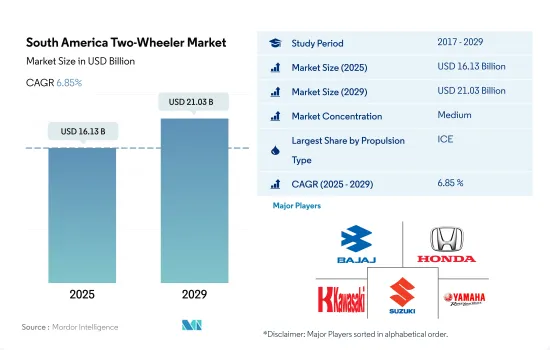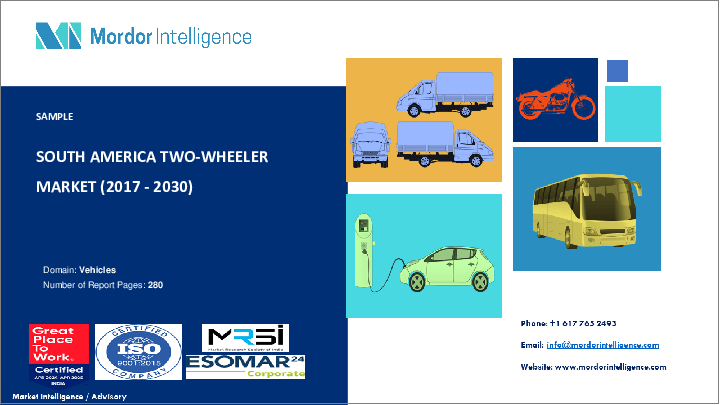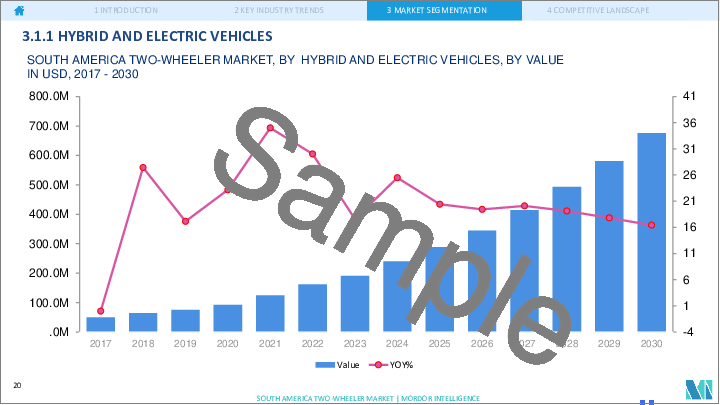|
|
市場調査レポート
商品コード
1684109
南米の二輪車:市場シェア分析、産業動向、成長予測(2025年~2029年)South America Two-Wheeler - Market Share Analysis, Industry Trends & Statistics, Growth Forecasts (2025 - 2029) |
||||||
カスタマイズ可能
適宜更新あり
|
|||||||
| 南米の二輪車:市場シェア分析、産業動向、成長予測(2025年~2029年) |
|
出版日: 2025年03月18日
発行: Mordor Intelligence
ページ情報: 英文 176 Pages
納期: 2~3営業日
|
全表示
- 概要
- 目次
南米の二輪車市場規模は2025年に161億3,000万米ドルと推定・予測され、2029年には210億3,000万米ドルに達し、予測期間(2025年~2029年)のCAGRは6.85%で成長すると予測されます。

南米の二輪車市場は、技術、政策、持続可能性を原動力に、伝統的嗜好と電動嗜好の融合によって成長する
- 2023年、南米の二輪車市場は緩やかな増加を見せ、販売台数は2022年の298万台から301万台に達しました。この成長は、景気回復、都市化の動向、手頃な価格のモビリティ・ソリューションに対するニーズの高まりを反映し、同地域で不可欠な交通手段として二輪車に対する需要が安定していることを示しています。二輪車の継続的な需要は、伝統的なICEモデルと、ハイブリッド車やEVへの関心の高まりの混合によって支えられています。
- 電動二輪車へのシフトは、世界標準と比べるとまだ初期段階にあるもの、EVインフラの改善、二酸化炭素排出量削減を目的とした政府のインセンティブ、環境持続可能性に対する消費者の意識の高まりに後押しされ、勢いを増しています。予測データによれば、南米全域の二輪車市場は成長を続けており、2030年には販売台数が422万台に達すると予測されています。この予想される成長軌道は、便利で費用対効果の高い交通手段としての二輪車の不変の魅力だけでなく、市場力学が電動化へと大きくシフトしていることを浮き彫りにしています。
- 技術の進歩によって電動二輪車がより利用しやすくなり、各国政府が支援政策を強化するにつれて、市場は持続可能なモビリティへと変革する態勢を整えています。この時期は、環境責任と交通革新に向けた世界の動向を反映し、電動モデルが二輪車市場の主流に組み込まれる傾向が強まると思われます。
南米では手ごろな価格の二輪車が都市移動に好まれるが、国によって普及率は異なります。
- 南米の二輪車市場は、経済的で実用的な交通手段として、モーターサイクルやスクーターへの嗜好が非常に強いです。経済的課題と安全性への懸念が蔓延しているが、特に電動二輪車セグメントにおける成長機会は、メーカーと政策立案者にとって、進化する消費者ニーズと持続可能性の目標に応える機会を提供しています。
- 南米の二輪車市場は、都市化、経済状況、交通インフラなどの要因の影響を受け、国ごとに多様な嗜好や利用パターンを反映しています。ブラジルは南米最大の二輪車市場であり、二輪車は人口の大部分にとって好ましい交通手段です。特に都市部や半都市部では、手頃な価格で効率的な交通手段へのニーズが市場を牽引しています。ブラジルは地場製造業が盛んで、大手世界・ブランドや地場ブランドが幅広い種類の二輪車を提供しています。
- また、多様な地形があるため、オフロード二輪車への関心も高いです。アルゼンチンの二輪車市場は、費用対効果の高い交通手段を求める通勤客と、レジャー用の二輪車を好む愛好家が混在しています。景気変動は市場に影響を与えたが、二輪車は所有と運転のコストが低いため、依然として人気のある選択肢です。市場はまだ初期段階にあるが、電動モデルへの関心が高まっています。
南米の二輪車市場動向
需要の急増と政府のインセンティブが南米の電気自動車市場を後押し
- 南米のブラジルやアルゼンチンといった国々は、自動車市場において大きな可能性を示しています。南米の自動車産業は近年著しい成長を遂げています。特にこの地域では、乗用車セグメントを中心に電気自動車(EV)の需要が高まっています。この急増は、意識の高まり、環境問題への関心の高まり、EV導入を促進する政府の取り組みといった要因によるものです。実際、同地域のEV販売台数は顕著な伸びを示し、2022年には2021年比で17.95%増加しました。
- 多様な市場を持つ南米では、電気自動車の急増が見込まれています。特にブラジルは、再生可能エネルギーによる発電を重視し、EVバッテリー開発に不可欠なニオブとリチウムの埋蔵量が豊富なことから、電気バスへのシフトを視野に入れています。2022年12月、サンパウロはディーゼルバスの購入を禁止し、2024年末までに2,600台の電気バスを導入する計画を発表しました。他の南米諸国でも同様の動向が見られ、2024年から2030年にかけて自動車の電動化が進むと予想されます。
- 南米各国の政府政策とインセンティブ・プログラムは、同地域における車両電化の重要な推進力となります。例えば、税制上の優遇措置は極めて重要な役割を果たしています。例えばコロンビア政府は、2030年までに60万台のEVを走らせるという野心的な目標を掲げ、インセンティブと補助金を活用して二酸化炭素排出量の削減に取り組んでいます。他の南米諸国でも同様の取り組みが予想されることから、EVの販売は2024年から2030年にかけて急増すると見込まれています。
南米の二輪車産業の概要
南米の二輪車市場は適度に統合されており、上位5社で61.02%を占めています。この市場の主要企業は以下の通り。 Bajaj Auto Ltd., Honda Motor, Kawasaki Heavy Industries Ltd., Suzuki Motor Corporation and Yamaha Motor Company Limited.
その他の特典
- エクセル形式の市場予測(ME)シート
- 3ヶ月のアナリストサポート
目次
第1章 エグゼクティブサマリーと主な調査結果
第2章 レポートのオファー
第3章 イントロダクション
- 調査の前提条件と市場定義
- 調査範囲
- 調査手法
第4章 主要産業動向
- 人口
- 一人当たりGDP
- 自動車購入のための消費者支出(cvp)
- インフレ率
- 自動車ローン金利
- 電化の影響
- EV充電ステーション
- バッテリーパック価格
- Xev新モデル発表
- 燃料価格
- 規制の枠組み
- バリューチェーンと流通チャネル分析
第5章 市場セグメンテーション
- 推進タイプ
- ハイブリッド車と電気自動車
- ICE(電気自動車)
- 国名
- アルゼンチン
- ブラジル
- その他の南米
第6章 競合情勢
- 主要な戦略動向
- 市場シェア分析
- 企業情勢
- 企業プロファイル
- Bajaj Auto Ltd.
- Harley-Davidson
- Hero MotoCorp Ltd.
- Honda Motor Co. Ltd.
- Kawasaki Heavy Industries Ltd.
- KTM Motorcycles
- Royal Enfield
- Suzuki Motor Corporation
- TVS Motor Company Limited
- Yamaha Motor Company Limited
第7章 CEOへの主な戦略的質問CEOへの主な戦略的質問
第8章 付録
- 世界概要
- 概要
- ファイブフォース分析フレームワーク
- 世界・バリューチェーン分析
- 市場力学(DROs)
- 情報源と参考文献
- 図表一覧
- 主要洞察
- データパック
- 用語集
The South America Two-Wheeler Market size is estimated at 16.13 billion USD in 2025, and is expected to reach 21.03 billion USD by 2029, growing at a CAGR of 6.85% during the forecast period (2025-2029).

The South American two-wheeler market is growing by blending traditional and electric preferences, driven by tech, policy, and sustainability
- In 2023, the South American market for two-wheelers saw a modest increase, with sales reaching 3,010,000 units from 2,980,000 units in 2022. This growth indicates a steady demand for two-wheelers as essential transportation tools in the region, reflecting the economic recovery, urbanization trends, and the increasing need for affordable mobility solutions. The ongoing demand for two-wheelers is supported by a mix of traditional ICE models and a growing interest in hybrid and EVs.
- The shift toward electric two-wheelers, although still in its early stages compared to global standards, is gaining momentum, fueled by improvements in EV infrastructure, governmental incentives aimed at reducing carbon emissions, and a growing consumer consciousness toward environmental sustainability. The forecasted data indicate continued growth in the two-wheeler market across South America, with sales projected to reach 4,220,000 units by 2030. This expected growth trajectory highlights not only the enduring appeal of two-wheelers as a convenient and cost-effective mode of transportation but also a significant shift in market dynamics toward electrification.
- As technological advancements make electric two-wheelers more accessible and governments enhance supportive policies, the market is poised for a transformative shift toward sustainable mobility. This period will likely witness an increasing integration of electric models into the mainstream two-wheeler market, reflecting broader global trends toward environmental responsibility and innovation in transportation.
Two-wheelers are preferred in South America for urban mobility due to affordability, with varying adoption rates across countries
- The two-wheeler market in South America has a very strong preference for motorcycles and scooters as economical and practical transportation options. While economic challenges and safety concerns are prevalent, the potential for growth, especially in the electric two-wheeler segment, presents opportunities for manufacturers and policymakers to cater to evolving consumer needs and sustainability goals.
- The two-wheeler market in South America reflects diverse preferences and usage patterns across different countries, influenced by factors such as urbanization, economic conditions, and transportation infrastructure. Brazil is the largest two-wheeler market in South America, with motorcycles being the preferred mode of transportation for a significant portion of the population. The market is driven by the need for affordable and efficient transportation solutions, especially in urban and semi-urban areas. Brazil has a robust local manufacturing industry, with major global and local brands offering a wide range of two-wheelers.
- The country also sees significant interest in off-road motorcycles due to its diverse terrain. The two-wheeler market in Argentina caters to a mix of commuters looking for cost-effective transport solutions and enthusiasts who prefer motorcycles for leisure. Economic fluctuations have impacted the market, but two-wheelers remain a popular choice due to their low cost of ownership and operation. There is a growing interest in electric models, although the market is still in its early stages.
South America Two-Wheeler Market Trends
Surging demand and government incentives propel South America's electric vehicle market
- Countries like Brazil and Argentina in South America show significant potential in the automobile market. The South American vehicle industry has witnessed notable growth in recent years. Notably, the region has seen a rising demand for electric vehicles (EVs), especially in the passenger car segment. This surge can be attributed to factors like heightened awareness, growing environmental concerns, and governmental initiatives promoting EV adoption. In fact, EV sales in the region saw a notable increase, growing by 17.95% in 2022 compared to 2021.
- South America, with its diverse markets, is poised for a surge in electric vehicles. Brazil, in particular, is eyeing a shift toward electric buses, driven by its focus on renewable power generation and its abundant reserves of niobium and lithium, crucial for EV battery development. A significant move in this direction came in December 2022 when Sao Paulo banned diesel bus purchases and announced plans to deploy 2600 electric buses by 2024-end. Similar trends in other South American nations are expected to drive vehicle electrification from 2024 to 2030.
- Government policies and incentive programs across South American nations are set to be key drivers for vehicle electrification in the region. Tax benefits, for instance, are playing a pivotal role. Colombia's government, for instance, is leveraging incentives and subsidies with an ambitious target of putting 600,000 EVs on its roads by 2030, aiming to tackle carbon emissions. With similar initiatives anticipated in other South American countries, the sales of EVs are expected to witness a surge from 2024 to 2030.
South America Two-Wheeler Industry Overview
The South America Two-Wheeler Market is moderately consolidated, with the top five companies occupying 61.02%. The major players in this market are Bajaj Auto Ltd., Honda Motor Co. Ltd., Kawasaki Heavy Industries Ltd., Suzuki Motor Corporation and Yamaha Motor Company Limited (sorted alphabetically).
Additional Benefits:
- The market estimate (ME) sheet in Excel format
- 3 months of analyst support
TABLE OF CONTENTS
1 EXECUTIVE SUMMARY & KEY FINDINGS
2 REPORT OFFERS
3 INTRODUCTION
- 3.1 Study Assumptions & Market Definition
- 3.2 Scope of the Study
- 3.3 Research Methodology
4 KEY INDUSTRY TRENDS
- 4.1 Population
- 4.2 GDP Per Capita
- 4.3 Consumer Spending For Vehicle Purchase (cvp)
- 4.4 Inflation
- 4.5 Interest Rate For Auto Loans
- 4.6 Impact Of Electrification
- 4.7 EV Charging Station
- 4.8 Battery Pack Price
- 4.9 New Xev Models Announced
- 4.10 Fuel Price
- 4.11 Regulatory Framework
- 4.12 Value Chain & Distribution Channel Analysis
5 MARKET SEGMENTATION (includes market size in Value in USD and Volume, Forecasts up to 2029 and analysis of growth prospects)
- 5.1 Propulsion Type
- 5.1.1 Hybrid and Electric Vehicles
- 5.1.2 ICE
- 5.2 Country
- 5.2.1 Argentina
- 5.2.2 Brazil
- 5.2.3 Rest-of-South America
6 COMPETITIVE LANDSCAPE
- 6.1 Key Strategic Moves
- 6.2 Market Share Analysis
- 6.3 Company Landscape
- 6.4 Company Profiles
- 6.4.1 Bajaj Auto Ltd.
- 6.4.2 Harley-Davidson
- 6.4.3 Hero MotoCorp Ltd.
- 6.4.4 Honda Motor Co. Ltd.
- 6.4.5 Kawasaki Heavy Industries Ltd.
- 6.4.6 KTM Motorcycles
- 6.4.7 Royal Enfield
- 6.4.8 Suzuki Motor Corporation
- 6.4.9 TVS Motor Company Limited
- 6.4.10 Yamaha Motor Company Limited
7 KEY STRATEGIC QUESTIONS FOR VEHICLES CEOS
8 APPENDIX
- 8.1 Global Overview
- 8.1.1 Overview
- 8.1.2 Porter's Five Forces Framework
- 8.1.3 Global Value Chain Analysis
- 8.1.4 Market Dynamics (DROs)
- 8.2 Sources & References
- 8.3 List of Tables & Figures
- 8.4 Primary Insights
- 8.5 Data Pack
- 8.6 Glossary of Terms





